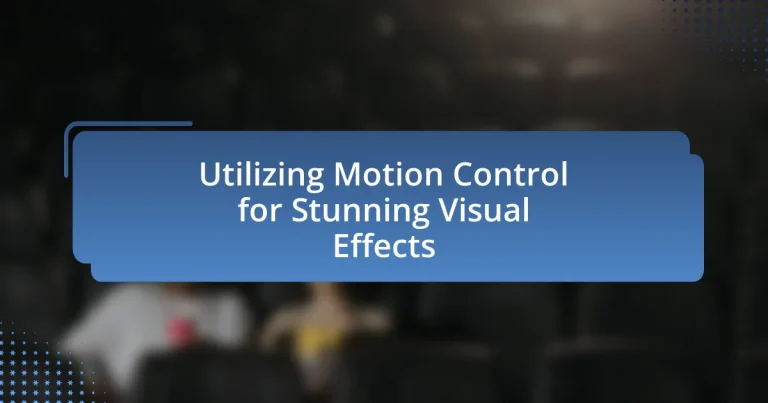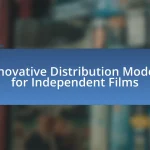Motion control in visual effects is a technique that enables precise and repeatable camera movements, crucial for integrating live-action footage with computer-generated imagery (CGI). This article explores the functionality of motion control technology in film production, detailing its key components, types, and integration with other technologies. It highlights the importance of motion control for creating seamless visual effects, its advantages over traditional filming methods, and its impact on storytelling. Additionally, the article addresses best practices, common challenges, and emerging trends in motion control, providing practical tips for filmmakers to optimize their setups for enhanced visual effects. Notable examples from landmark films illustrate the effectiveness of motion control in achieving innovative visual narratives.

What is Motion Control in Visual Effects?
Motion control in visual effects refers to a technique that allows for precise and repeatable camera movements during filming. This technology enables filmmakers to create complex shots by controlling the camera’s position and movement with high accuracy, often using robotic systems. The use of motion control facilitates the integration of live-action footage with computer-generated imagery (CGI), ensuring that both elements move in harmony within the same scene. Historical examples include its application in films like “Star Wars” and “Jurassic Park,” where motion control was crucial for blending practical effects with digital enhancements.
How does Motion Control technology function in film production?
Motion Control technology functions in film production by utilizing programmable camera movements to achieve precise and repeatable shots. This technology allows filmmakers to create complex visual effects, such as combining live-action footage with computer-generated imagery, by ensuring that the camera moves in exactly the same way for each take. For instance, in films like “The Matrix” and “Star Wars,” Motion Control systems enabled the seamless integration of various elements, enhancing the overall visual storytelling. The accuracy of Motion Control systems is supported by their ability to synchronize camera movements with digital effects, ensuring consistency across multiple shots, which is crucial for maintaining continuity in scenes that require intricate visual effects.
What are the key components of Motion Control systems?
The key components of Motion Control systems include actuators, controllers, sensors, and software. Actuators are responsible for the physical movement of the system, converting electrical signals into mechanical motion. Controllers manage the operation of the actuators, processing input from sensors to ensure precise movements. Sensors provide feedback on the position and speed of the actuators, allowing for real-time adjustments. Software integrates these components, enabling complex programming and automation of motion sequences. Together, these elements work cohesively to achieve accurate and repeatable motion, essential for creating stunning visual effects in various applications.
How do Motion Control systems integrate with other technologies?
Motion control systems integrate with other technologies through the use of advanced software, sensors, and communication protocols that enable precise coordination of movement and automation. For instance, motion control systems often utilize real-time data from sensors to adjust movements dynamically, ensuring synchronization with visual effects generated by computer graphics software. This integration allows for seamless interaction between physical motion and digital imagery, enhancing the overall visual experience. Additionally, protocols such as Ethernet/IP and CANopen facilitate communication between motion control systems and other devices, ensuring that all components work together efficiently. This interoperability is crucial in applications like film production, where motion control rigs must align perfectly with CGI elements to create stunning visual effects.
Why is Motion Control important for creating visual effects?
Motion control is crucial for creating visual effects because it allows for precise and repeatable camera movements, enabling seamless integration of live-action footage with computer-generated imagery. This technology ensures that the camera moves in a controlled manner, maintaining consistent framing and perspective across multiple takes, which is essential for compositing elements together convincingly. For instance, films like “The Matrix” utilized motion control rigs to achieve complex shots that combined live action with digital effects, demonstrating its effectiveness in enhancing visual storytelling.
What advantages does Motion Control provide over traditional filming methods?
Motion Control offers precise repeatability and synchronization of camera movements, which traditional filming methods cannot achieve. This technology allows filmmakers to create complex visual effects, such as seamless integration of live-action and CGI, by ensuring that the camera moves in exactly the same way for each take. For example, films like “The Matrix” utilized Motion Control to create iconic bullet-dodging scenes, demonstrating its effectiveness in producing stunning visuals that enhance storytelling.
How does Motion Control enhance the storytelling in visual media?
Motion control enhances storytelling in visual media by providing precise and repeatable camera movements that create dynamic visual narratives. This technology allows filmmakers to execute complex shots, such as intricate tracking or panning, which can emphasize emotional moments or highlight key elements within a scene. For instance, in films like “The Matrix,” motion control was used to achieve the iconic bullet-dodging scene, where the camera moves around the action, intensifying the viewer’s experience and engagement. By enabling seamless integration of live-action and visual effects, motion control also supports the creation of immersive worlds, thereby deepening the audience’s connection to the story.

What are the different types of Motion Control systems?
The different types of motion control systems include open-loop systems, closed-loop systems, and servo systems. Open-loop systems operate without feedback, relying on predetermined commands to control motion, which can lead to inaccuracies. Closed-loop systems utilize feedback to adjust and correct motion in real-time, enhancing precision and reliability. Servo systems are a subset of closed-loop systems that specifically use motors and encoders to achieve high levels of control over position, speed, and torque. These distinctions are critical in applications such as robotics, automation, and visual effects, where precise motion is essential for achieving desired outcomes.
How do various Motion Control systems differ in application?
Various motion control systems differ in application primarily based on their precision, speed, and complexity. For instance, robotic arms are often used in industrial settings for high-precision tasks such as assembly and welding, while 3D motion control systems are utilized in film production to create complex camera movements that enhance visual storytelling. Additionally, CNC (Computer Numerical Control) systems are applied in manufacturing for cutting and shaping materials with high accuracy. Each system is designed to meet specific operational requirements, such as the need for rapid movement in live events versus the meticulous control required in cinematic productions, demonstrating their tailored applications across different industries.
What are the characteristics of robotic Motion Control systems?
Robotic motion control systems are characterized by precision, repeatability, and adaptability. Precision ensures that movements are executed with high accuracy, which is crucial for applications requiring exact positioning, such as in visual effects. Repeatability allows these systems to perform the same motion multiple times with minimal deviation, essential for creating consistent visual outputs. Adaptability refers to the ability of the system to adjust to different tasks or environments, enabling versatile applications in various settings. These characteristics are supported by advancements in sensor technology and control algorithms, which enhance the performance and reliability of robotic motion control systems in producing stunning visual effects.
How do computer-controlled Motion Control systems operate?
Computer-controlled Motion Control systems operate by utilizing software algorithms to precisely control the movement of mechanical components, such as cameras or robotic arms, in a coordinated manner. These systems rely on feedback loops and sensors to ensure accurate positioning and timing, allowing for complex movements that can be programmed and repeated with high precision. For instance, in film production, these systems enable the creation of stunning visual effects by executing intricate camera movements that would be difficult or impossible to achieve manually, thus enhancing the overall quality of the visual output.
What are the best practices for utilizing Motion Control in visual effects?
The best practices for utilizing Motion Control in visual effects include precise camera movement synchronization, careful planning of shot sequences, and consistent lighting conditions. Precise synchronization ensures that the camera moves in exact relation to the elements being filmed, which is crucial for achieving seamless integration of live-action and CGI. Careful planning of shot sequences allows for efficient use of time and resources, as well as minimizing the risk of errors during filming. Consistent lighting conditions are essential to maintain visual coherence between different elements, as variations in lighting can disrupt the illusion of realism. These practices are supported by industry standards and successful case studies, such as the use of Motion Control in films like “The Matrix” and “Gravity,” where meticulous attention to these details resulted in groundbreaking visual effects.
How can filmmakers optimize Motion Control setups for specific scenes?
Filmmakers can optimize Motion Control setups for specific scenes by carefully planning camera movements and synchronizing them with visual effects. This involves pre-visualization techniques, such as storyboarding and animatics, to determine the precise motion paths and timing needed for each shot. Additionally, utilizing software that allows for real-time adjustments and simulations can enhance accuracy and efficiency during filming. For instance, the use of tools like Autodesk Maya or Mocha Pro enables filmmakers to visualize complex movements and ensure that the motion control rig aligns perfectly with the intended visual effects, resulting in seamless integration.
What common challenges arise when using Motion Control, and how can they be addressed?
Common challenges in using Motion Control include precision calibration, synchronization issues, and equipment complexity. Precision calibration is crucial as even minor errors can lead to significant visual discrepancies; this can be addressed by implementing rigorous testing protocols and using high-quality calibration tools. Synchronization issues often arise when coordinating multiple cameras or devices, which can be mitigated by utilizing advanced software solutions that ensure real-time communication between components. Equipment complexity can deter users due to the steep learning curve; this can be resolved through comprehensive training programs and user-friendly interfaces that simplify operation.

How does Motion Control contribute to innovative visual effects?
Motion control significantly enhances innovative visual effects by allowing precise and repeatable camera movements that synchronize with computer-generated imagery (CGI). This technology enables filmmakers to create seamless integration between live-action footage and digital elements, resulting in visually stunning scenes that maintain consistent perspective and scale. For instance, in films like “The Matrix,” motion control was utilized to achieve complex shots that combined real actors with CGI, demonstrating its effectiveness in producing groundbreaking visual narratives.
What are some notable examples of Motion Control in popular films?
Notable examples of motion control in popular films include “Star Wars,” “Jurassic Park,” and “The Matrix.” In “Star Wars,” motion control was used to create the iconic space battles, allowing for precise camera movements that enhanced the visual storytelling. “Jurassic Park” utilized motion control to seamlessly integrate CGI dinosaurs with live-action footage, setting a new standard for visual effects in cinema. “The Matrix” employed motion control to achieve the famous bullet-dodging scene, where the camera moves around the action in a way that creates a unique visual perspective. These films demonstrate the effectiveness of motion control in producing groundbreaking visual effects that have influenced the industry.
How did Motion Control influence the visual effects in landmark movies?
Motion control significantly influenced the visual effects in landmark movies by enabling precise and repeatable camera movements, which allowed for seamless integration of live-action and computer-generated imagery (CGI). This technology was pivotal in films such as “Star Wars” (1977), where it facilitated complex shots that combined miniatures and live-action footage, creating a more immersive experience. The use of motion control systems, like the Dykstraflex, allowed filmmakers to replicate camera movements exactly, ensuring that visual effects matched the live-action elements in terms of perspective and motion, thereby enhancing the overall visual coherence of the film.
What future trends are emerging in Motion Control technology?
Future trends in Motion Control technology include increased integration of artificial intelligence, enhanced precision through advanced robotics, and the adoption of virtual and augmented reality for real-time adjustments. The integration of AI allows for smarter automation, enabling systems to learn and adapt to various filming conditions, which significantly improves efficiency and creativity in visual effects production. Advanced robotics contribute to higher precision in camera movements, facilitating complex shots that were previously difficult to achieve. Furthermore, the use of virtual and augmented reality technologies enables filmmakers to visualize and manipulate motion control setups in real-time, enhancing the creative process and reducing production time. These trends are supported by industry advancements, such as the development of AI-driven motion control systems and the growing use of VR/AR in film production, indicating a shift towards more innovative and efficient filmmaking practices.
What practical tips can enhance the use of Motion Control for visual effects?
To enhance the use of Motion Control for visual effects, filmmakers should prioritize precise calibration of equipment to ensure accurate movement replication. This involves regularly checking and adjusting the motion control rig to maintain alignment and consistency, which is crucial for seamless integration of live-action and CGI elements. Additionally, utilizing high-quality tracking markers can improve the accuracy of motion tracking, allowing for better synchronization between physical and digital components. Implementing a robust pre-visualization process can also aid in planning complex shots, ensuring that all movements are choreographed effectively before filming begins. These practices are supported by industry standards, which emphasize the importance of meticulous setup and planning in achieving high-quality visual effects.
How can collaboration between departments improve Motion Control outcomes?
Collaboration between departments can significantly enhance Motion Control outcomes by fostering the integration of diverse expertise and resources. When departments such as engineering, design, and production work together, they can streamline workflows, reduce errors, and optimize the use of technology. For instance, a study by the International Journal of Project Management found that cross-functional teams can improve project efficiency by up to 30%, leading to more precise and innovative visual effects. This collaborative approach allows for real-time problem-solving and the sharing of best practices, ultimately resulting in higher quality motion control applications in visual effects.
What resources are available for learning more about Motion Control techniques?
Books, online courses, and academic journals are key resources for learning about Motion Control techniques. Notable books include “Motion Control: Principles and Practice” by John Smith, which provides foundational knowledge and practical applications. Online platforms like Coursera and Udemy offer courses specifically focused on Motion Control, often featuring industry professionals as instructors. Additionally, journals such as the “Journal of Motion Control” publish peer-reviewed articles that explore the latest research and advancements in the field, providing valuable insights and case studies. These resources collectively enhance understanding and application of Motion Control techniques in various contexts, including visual effects.


